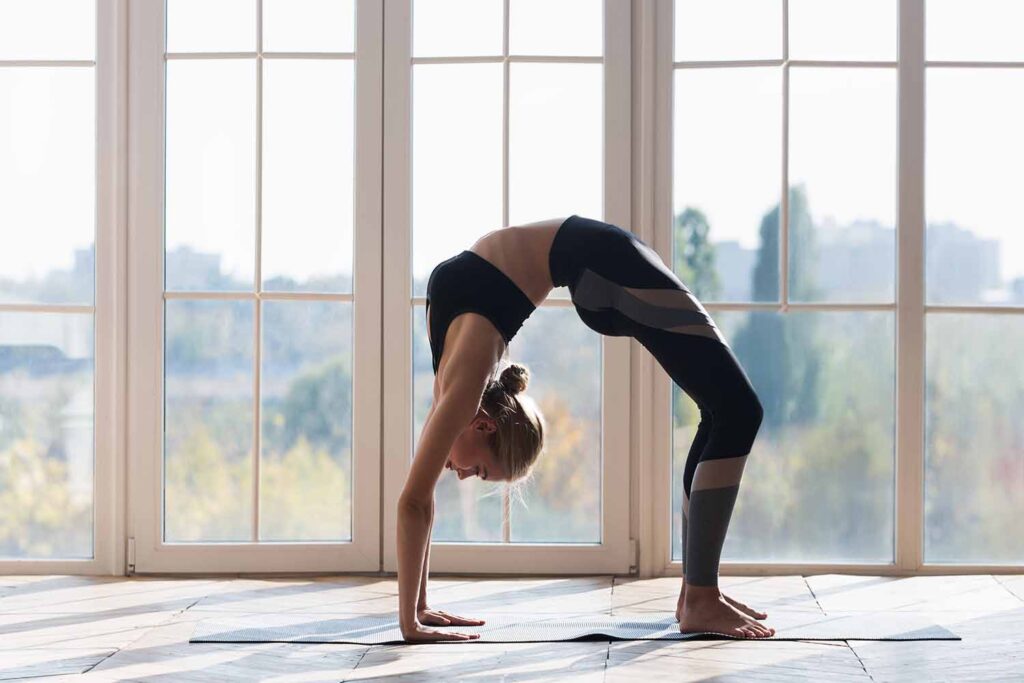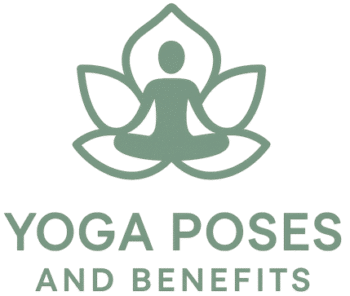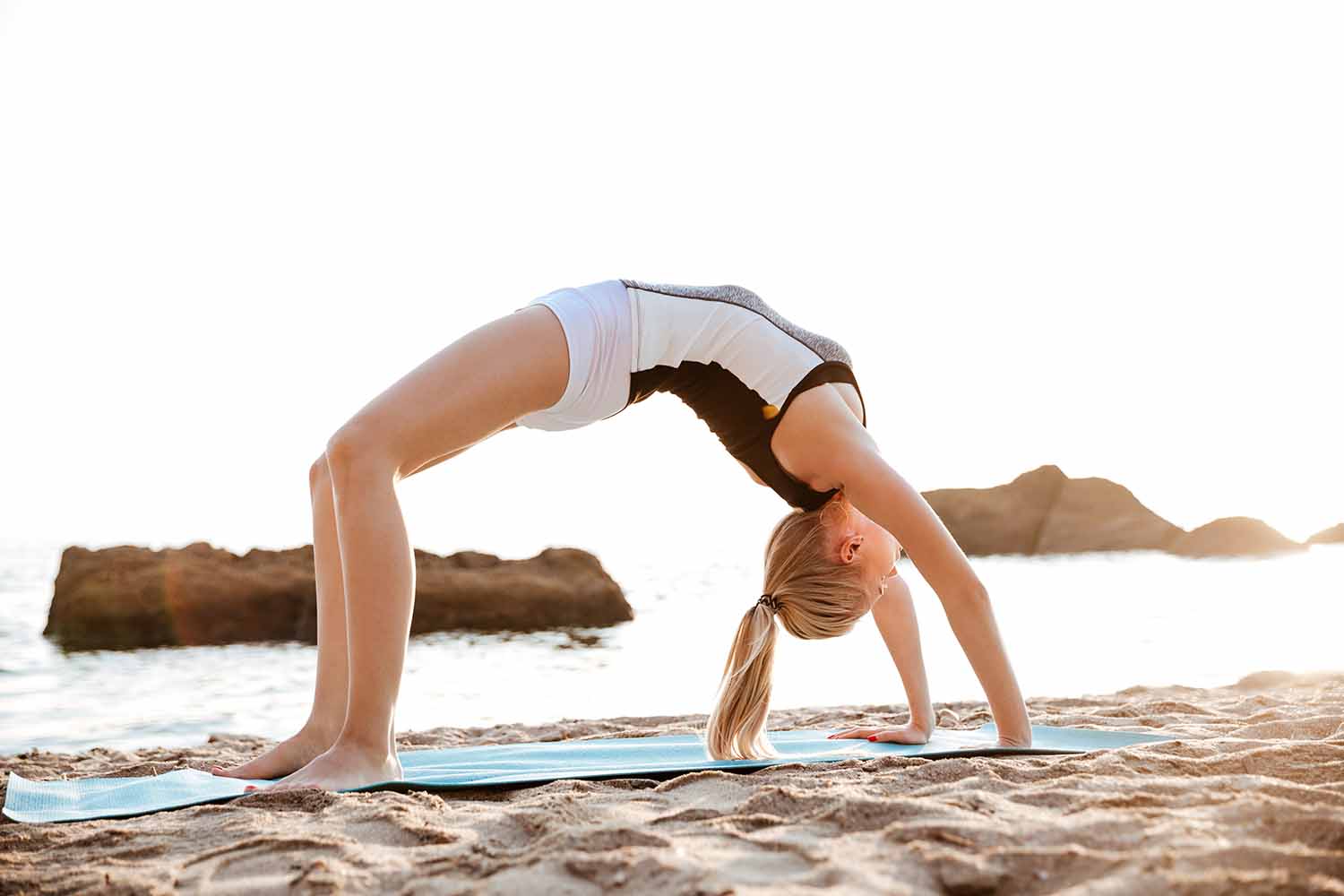Wheel Pose (Urdhva Dhanurasana) is an intense backbend that opens the chest, stretches the front body, and strengthens the arms, legs, and spine. This pose requires both flexibility and strength, making it a powerful addition to intermediate and advanced yoga practices. Practicing Wheel Pose can promote a sense of vitality and boost energy levels, as it encourages deep breathing and heart opening.
To enter Wheel Pose, begin lying on your back with your knees bent and feet hip-width apart. Place your hands beside your ears, fingers pointing toward your shoulders. As you inhale, press into your hands and feet to lift your hips and chest off the mat. Straighten your arms and legs as much as possible, keeping your feet grounded and your knees aligned. Engage your core and thighs to support your lower back.
Maintaining proper alignment is key. Ensure your arms and legs are active, and avoid letting your knees or elbows splay outward. Keep your gaze between your hands or slightly behind you to protect your neck.
Wheel Pose enhances flexibility in the spine, strengthens the entire body, and can elevate your mood. It also acts as an energizing posture that helps release tension and improve posture over time.
Other Names for Wheel Yoga Pose
Wheel Pose, a powerful backbend also known for its energizing effects, is referred to by several names across different practices:
- Chakrasana
- Urdhva Dhanurasana
- Upward Bow Pose
- Full Wheel Pose
How to do Wheel Pose in Yoga
To perform Wheel Pose effectively, begin by following these steps:
1. Start lying on your back, with your knees bent and feet flat on the mat, hip-width apart. Place your hands behind your head, fingers pointing toward your shoulders.
2. Press into your feet and lift your hips toward the ceiling. Ensure your shoulders remain open by pressing your upper arms into the mat.
3. Place your hands under your shoulders, with fingers pointing toward your feet. Elbows should bend backward, allowing your shoulders to open.
4. Push through your hands and feet, lifting your chest and thighs off the ground. Engage your core to support your lower back and maintain stability.
5. Gently press your feet and hands into the mat, while actively pushing your chest upward. Aim to create a deep arch in your back, with your head floating between your arms.
Hold this position for several breaths. To exit, slowly lower your back down, release your hands, and relax.
Variations of Wheel Yoga Pose
Variations of Wheel Pose offer different ways to deepen your practice and cater to various skill levels. These modifications can enhance flexibility, strength, and balance.
- Half Wheel Pose: Begin by lifting only your upper body, keeping your lower back on the floor. This variation provides a gentle introduction to the full pose and builds confidence.
- One-Legged Wheel Pose: While in Wheel Pose, lift one leg off the ground. This adjustment challenges your balance and core strength, adding an extra layer of complexity.
- Wheel Pose with Block: Place a block between your thighs to help engage your inner thighs and maintain alignment. This variation supports proper form and increases stability.
- Supported Wheel Pose: Use a bolster or block under your back for extra support. Ideal for beginners or those with limited flexibility, this version eases into the full backbend.
- Wheel Pose with Hands on Feet: Instead of placing your hands on the floor, reach back to grasp your feet. This deepens the stretch and enhances the backbend.
Each variation serves a specific purpose, allowing you to modify the pose according to your needs while progressively building strength and flexibility.
Modifications for Wheel Yoga Pose
Modifications of Wheel Pose can help you build strength and flexibility while preventing injury. If you find the full expression of Wheel challenging, incorporating these adjustments can ease your practice while maintaining alignment.
- Bridge Pose: Start with Bridge Pose by lifting your hips while keeping your feet and shoulders grounded. This modification helps prepare your spine for deeper backbends without putting excessive strain on your wrists or shoulders.
- Hands on Blocks: Place yoga blocks under your hands to elevate the floor. This adjustment reduces the pressure on your wrists and shoulders, allowing you to ease into the pose while focusing on opening your chest.
- Wall Support: Perform Wheel Pose with your feet pressing against a wall. The wall provides stability and support, helping you achieve proper alignment while gradually building strength and flexibility.
- Bent Elbows: If straightening your arms is difficult, try keeping your elbows bent as you lift into the pose. This decreases the intensity on the upper body while allowing you to experience the benefits of the backbend.
- Use of a Strap: Place a yoga strap around your upper arms to prevent your elbows from splaying out. This modification supports alignment in the shoulders and promotes safer engagement.
These modifications can make Wheel Pose more accessible as you build strength and flexibility.
Contraindications for Wheel Pose in Yoga
Wheel Pose (Urdhva Dhanurasana) is an advanced backbend that offers deep stretching and opening. However, it also presents risks if practiced with certain conditions. Understanding contraindications for Wheel Pose is essential to avoid injury and discomfort.
- Lower back issues: This pose places intense pressure on the spine. Those with herniated discs or general lower back pain should approach Wheel Pose cautiously. Modify with Bridge Pose to reduce spinal stress.
- Wrist injuries: Supporting the body in this pose requires strong wrists. Anyone with carpal tunnel syndrome, wrist pain, or injuries should avoid or modify Wheel Pose, using blocks under the hands to reduce strain.
- Shoulder tightness or injury: Full shoulder extension is needed in Wheel Pose. If you have any shoulder issues, such as rotator cuff injuries, this deep extension can exacerbate the problem. Consider working on gentler backbends first.
- Neck issues: Extending the neck in Wheel Pose may worsen pre-existing neck pain. Focus on keeping a neutral head position or opt for a supported backbend.
- Heart conditions: The deep opening of the chest in Wheel Pose can be overwhelming for those with heart conditions. Choose a gentler heart opener, like Cobra Pose, to avoid unnecessary strain.
Practicing Wheel Pose with awareness of these contraindications allows for a safer and more sustainable practice.
Tips to improve Wheel yoga pose in your practice
Improving your Wheel Pose (Urdhva Dhanurasana) requires mindful attention to alignment, strength, and flexibility. Here are key tips to help you deepen the pose while maintaining safety.

- Warm up thoroughly: Prepare your spine and shoulders with poses like Cobra, Bridge, and Downward Dog to ensure flexibility and mobility before attempting Wheel.
- Engage your core and glutes: Activating your core stabilizes your lower back, while engaging your glutes helps lift your hips higher, creating a strong foundation for the backbend.
- Press into your hands and feet: Actively push into the ground with both hands and feet to distribute weight evenly, relieving pressure from your wrists and shoulders.
- Work on shoulder mobility: Focus on opening your chest and shoulders to lift further into the pose without overcompressing the lower back.
- Align your knees and feet: Keep your knees aligned with your feet, hip-distance apart, to prevent unnecessary strain on the knees and lower back.
- Focus on lengthening: Instead of collapsing into the lumbar spine, aim to lengthen through the front body, lifting your chest while keeping the neck relaxed.
- Use props: Place blocks under your hands for extra support and to help ease into the pose gradually.
Practicing these tips will help you improve your strength, flexibility, and form in Wheel Pose.
What Muscles Does Wheel Pose Work?
Wheel Pose in yoga (Urdhva Dhanurasana) is a powerful full-body backbend that activates and strengthens various muscle groups. When practiced with mindful engagement, this pose can build strength and flexibility across your entire body.
- Quadriceps: As you press through your feet and lift your hips, your quadriceps engage to extend your legs and support the backbend.
- Glutes: The gluteal muscles (gluteus maximus) are engaged to stabilize the pelvis and lift the hips, providing the strength necessary for a controlled backbend.
- Hip Flexors: Stretching the hip flexors, particularly the psoas, Wheel Pose in yoga opens up the front body and relieves tightness in the hips.
- Spinal Erectors: These muscles along the spine work hard to create the deep backbend, improving flexibility and overall spinal strength.
- Shoulders and Arms (Deltoids, Triceps): As your hands press into the ground, your shoulders and arms engage to help lift the chest and support the weight of your upper body.
- Chest (Pectorals): The pectoral muscles are stretched as your chest lifts and opens, promoting better posture and expansion of the ribcage.
- Core Muscles (Abdominals): Though primarily stretched, the core muscles, including the rectus abdominis and obliques, are also subtly engaged to maintain balance and support the arch of the back.
Wheel Pose works these muscle groups to improve strength, flexibility, and endurance across the body.
Mental and Emotional Benefits of Wheel Pose in Yoga?
Wheel Pose in yoga (Urdhva Dhanurasana) not only challenges the body but also offers profound mental and emotional benefits. This deep backbend opens the chest and heart, encouraging a shift in emotional states and fostering mental clarity.
- Emotional Release: Backbends like Wheel Pose can help release stored emotional tension, especially in the heart and chest area. This can result in feelings of lightness and emotional balance.
- Increased Confidence: The powerful, expansive nature of Wheel Pose boosts self-esteem and confidence. As the chest opens and the body stretches upward, a sense of empowerment and courage is cultivated.
- Enhanced Focus: Holding Wheel Pose requires concentration and determination. By maintaining awareness of your body’s alignment and strength, your mind becomes more present, sharpening your focus.
- Stress Reduction: Wheel Pose in yoga helps relieve physical tension, particularly in the spine and shoulders, areas where stress commonly accumulates. Releasing this tension can also help ease mental and emotional stress.
- Energy and Vitality: This pose activates the body’s energy channels, leaving you feeling refreshed and energized. The combination of physical effort and heart-opening effects can promote a heightened sense of vitality and emotional well-being.
Incorporating Wheel Pose into your yoga practice fosters emotional balance, mental clarity, and a renewed sense of energy and confidence.
Is Wheel Yoga pose suitable for beginners?
Wheel Pose in yoga (Chakrasana) can be quite demanding for beginners due to its intense backbend and overall strength requirements. Nonetheless, it can be adapted to accommodate those newer to yoga.
- Foundation Building: Before attempting Wheel Pose, practice foundational poses that strengthen the back, shoulders, and core. Poses such as Bridge Pose and Cobra Pose build the necessary muscle strength and flexibility.
- Use of Props: Employing props can significantly assist beginners. Placing a block under the hands or feet provides extra support and helps in achieving better alignment and stability.
- Modified Approach: Beginners might start with simpler backbends like Bridge Pose before progressing to Wheel Pose. Gradually increasing the range of motion prepares the body for the full expression of the pose.
- Focus on Alignment: Pay careful attention to alignment to avoid unnecessary strain. Ensure the feet are hip-width apart and the hands are firmly planted. Keep the thighs engaged and avoid collapsing into the lower back.
- Listen to Your Body: It’s essential to respect personal limits. If discomfort arises, it’s wise to ease back into a less intense variation or use additional props for support.
By incorporating these adjustments, beginners can safely approach Wheel Pose in yoga, fostering strength and flexibility over time.
Is Wheel Yoga pose suitable for advanced practitioners?
Wheel Pose (Chakrasana) is highly suitable for advanced practitioners, offering a range of challenges and benefits.
- Deep Backbend: Advanced students can fully exploit the depth of this backbend, reaching a more intense stretch in the chest and spine.
- Strength and Balance: This pose demands significant strength and balance. Advanced practitioners can refine their control and alignment, balancing the power of the pose with stability.
- Advanced Variations: To increase difficulty, experienced yogis may incorporate variations like one-legged wheel or transition into and out of Wheel Pose from other complex asanas.
- Alignment Precision: Perfecting alignment becomes crucial. Advanced practitioners focus on achieving a straight line from hands to feet and engaging core muscles to protect the lower back.
- Breath and Focus: Mastery of breath control and mental concentration enhances the pose. Advanced practitioners use deep, controlled breathing to maintain the pose and increase their focus.
- Mental Challenge: The intensity of Wheel Pose provides a mental challenge, pushing practitioners to overcome fear and build confidence.
Overall, Wheel Pose provides advanced practitioners with a platform to deepen their physical and mental practice, pushing the limits of flexibility and strength while cultivating focus and resilience.
How does Wheel pose contribute to a yoga sequence or flow?
Wheel Pose (Chakrasana) contributes powerfully to a yoga sequence or flow by enhancing strength, flexibility, and energy dynamics. Its integration can elevate the practice significantly.
- Builds Strength: Wheel Pose challenges and strengthens multiple muscle groups, including the back, shoulders, and arms. Incorporating this pose builds foundational strength necessary for advanced postures.
- Enhances Flexibility: By stretching the front body and spine, Wheel Pose deepens flexibility, particularly in the chest and hips. This increased flexibility facilitates smoother transitions between poses.
- Activates Core Muscles: Maintaining stability in Wheel Pose requires significant core engagement. Strengthening the core enhances overall balance and stability in the sequence.
- Improves Posture: Wheel Pose encourages an open chest and improved spinal alignment, promoting better posture throughout the practice. Improved alignment supports more effective execution of subsequent poses.
- Boosts Energy Flow: This pose stimulates and energizes the entire body by opening up the heart center and activating the spine. Enhanced energy flow supports an invigorating and dynamic practice.
- Offers Emotional Release: Often considered a heart-opening pose, Wheel Pose can help in releasing emotional tension. This emotional release contributes to a more balanced and mindful practice.
Incorporating Wheel Pose into your practice not only improves strength and flexibility but also enhances energy flow, core stability, and emotional well-being, enriching the overall flow of the yoga sequence.
How can I deepen my practice in Wheel pose?
To deepen your practice in Wheel Pose, focus on refining your alignment, strength, and flexibility. Here’s how you can enhance this challenging pose:
- Warm-Up Thoroughly: Begin with a comprehensive warm-up to prepare your body. Poses like Bridge Pose, Cobra Pose, and various backbends can help increase flexibility and strength in the spine.
- Engage the Core: Activate your abdominal muscles to support your lower back. A strong core stabilizes the body and allows for a deeper backbend without overstraining your lower back.
- Press into the Feet: Firmly press your feet into the mat to lift your hips higher. Ensure your feet are parallel and hip-width apart to provide a stable base.
- Align the Hands: Spread your fingers wide and press them firmly into the mat. This action helps distribute weight evenly and provides better support for lifting.
- Expand the Chest: As you lift, focus on expanding your chest and pushing it towards the wall behind you. This broadens your upper body and helps you achieve a deeper backbend.
- Lengthen the Spine: Imagine lengthening your spine as you lift. This creates more space between each vertebra and enhances the stretch.
- Use Props if Needed: Place a block or bolster under your back to support and deepen the pose gradually. Props can help you access the full range of the pose safely.
By incorporating these tips, you will deepen your Wheel Pose practice, allowing for more effective and enjoyable sessions.
What are some common mistakes in teaching Wheel Yoga Pose?
Common mistakes in teaching Wheel Pose can hinder both safety and effectiveness. To address these issues, focus on the following:
- Incorrect Hand Placement: Students might place hands too close to the head or too wide. Direct them to keep hands shoulder-width apart and fingers facing the feet for proper alignment.
- Overarching the Lower Back: Allowing the lower back to collapse can cause strain. Encourage students to engage their core and lift from the pelvis to distribute the backbend more evenly.
- Inadequate Foot Positioning: Feet should be hip-width apart and firmly grounded. Advise students to avoid letting their feet splay out or excessively turn inwards, which can destabilize the pose.
- Neglecting Shoulder Engagement: Students may not engage their shoulders enough, leading to excessive pressure on the wrists. Teach them to press firmly into the ground and draw the shoulders away from the ears.
- Straining the Neck: Allowing the head to hang or craning the neck can lead to discomfort. Remind students to keep their neck in a neutral position and avoid turning it while in the pose.
- Forcing the Pose: Pressuring students to achieve full expression can lead to injury. Encourage gradual progression and respect for personal limits to build strength and flexibility safely.
- Ignoring Warm-Up: Omitting preparatory poses can lead to muscle strain. Recommend a thorough warm-up focusing on the chest, shoulders, and hips to prepare the body for Wheel Pose.
By correcting these mistakes, you can support a safer and more effective practice of Wheel Pose.

